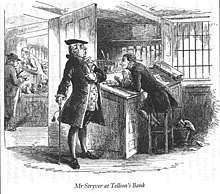Stryver
Stryver is a character in Charles Dickens's 1859 novel A Tale of Two Cities and in the 10 TV/film adaptations of the story. He is a barrister in London, with the character Sydney Carton working under him.
| Stryver | |
|---|---|
| A Tale of Two Cities character | |
 Mr Stryver at Tellson's Bank by Phiz, 1859 | |
| Created by | Charles Dickens |
| In-universe information | |
| Gender | Male |
| Occupation | Lawyer |
| Nationality | English |
Real life inspiration for the character
Bill Reisman (Taylor & Francis, 1993), 541.
Depiction in the novel
He first appears in the novel as counsel for the defense of Charles Darnay.[1] He then reappears in Sydney Carton's introductory chapter as his friend, drinking companion, and partner in law;[2] however, while he cuts a very impressive figure in court, it is apparent that Carton seems to have all the true legal knowledge and ability. While he and Sydney Carton were students at the same university of law, it appears that Stryver may have graduated due to Carton's doing all his scholastic work for him. Based on repeated descriptions of him as a "shoulderer" and a "thruster" and his own name, it can be implied that Styver is a very ambitious man determined to push himself to the top of his profession and in society. He later tells Sydney that he intends to marry Lucie Manette; however, after consulting Jarvis Lorry he decides against it and even talks himself into such a state that he congratulates himself upon his decision.[3] He is also a man of strong prejudices; at Tellson's bank in Chapter 24 when Charles Darnay says that he knows the new Marquis St. Evremonde, Stryver says "I am sorry a man who instructs youth knows him,"[4] not knowing that the Marquis St. Evremonde is Charles himself.
Depiction on stage
Wayne Schroder played "C. J. Stryver" in "the Broadway-aimed musical by Jill Santoriello."[5]
References
- Dickens, Charles (1997). A Tale of Two Cities and Related Readings, p. 90. McDougal Littel. ISBN 0-395-77544-2
- Dickens, Charles (1997). A Tale of Two Cities and Related Readings, pp. 140-111. McDougal Littel. ISBN 0-395-77544-2
- Dickens, Charles (1997). A Tale of Two Cities and Related Readings, pp. 169-182. McDougal Littel. ISBN 0-395-77544-2
- Dickens, Charles (1997). A Tale of Two Cities and Related Readings, p. 294. McDougal Littel. ISBN 0-395-77544-2
- Kenneth Jones, ""Best of Times" Is Now: Tale of Two Cities Musical Begins Pre-NYC Run Oct. 13," Playbill (13 Oct 2007).